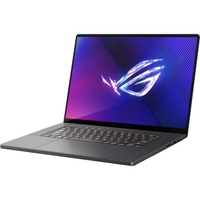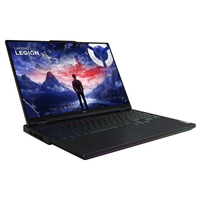Windows Central Verdict
The Razer Blade 16's long-awaited redesign results in a dramatic year-over-year improvement, helping elevate the ultra-premium gaming laptop back to the top. New AMD and NVIDIA hardware also deliver excellent and reliable performance, but the Blade 16 is still consistently outmatched by more affordable laptops — because you're paying a lot just for the design.
Pros
- +
Thinner, lighter, and beautiful redesign
- +
Substantially improved keyboard with great per-key, two-level RGB lighting
- +
Good, reliable sustained performance for gaming and productivity
Cons
- -
Performance isn't meaningfully better, especially off the charger
- -
Battery life hasn't improved, either
- -
Yeah, still really expensive
Why you can trust Windows Central
The Razer Blade 16 is ending years of languid iteration with a full redesign that aims to return Razer's flagship laptop to its throne.
The bloated chassis of the Razer Blade 16 (2024) I reviewed last year has been massively trimmed down to deliver the thinnest Razer Blade 16 ever, but still packs the deepest and most comfortable keyboard Razer has ever put in a laptop.
Intel has been left behind, with Razer relying on AMD for the very first time in its hero device, while the latest generation of NVIDIA GPUs helps usher in the new era with promised advancements in performance, efficiency, and AI.
The combination of all these improvements and the lack of any notable downgrades over the previous generation make the Razer Blade 16 a standout ultra-premium option yet again, but a recommendation isn't quite so clear-cut.
That meticulously crafted unibody design still demands a heavy price, and the Blade 16 still isn't close to being the most powerful gaming laptop you can get — even if you're looking to spend less.

I've reviewed dozens of laptops, desktops, and gaming hardware during my time at Windows Central, and I've been using all manner of Windows devices for many years before that. From the entry-level notebooks to the most exorbitant gaming laptops, I know what to look for to help inform your purchasing decision.
Disclaimer
This review was made possible thanks to a review sample provided by Razer. Razer had no input nor saw the contents of this review prior to publication.
Razer Blade 16 review: Cheat sheet
- What is it? A high-end gaming laptop that aims to balance premium design, portability, and performance.
- Who is it for? Those who aren't concerned about cost, and simply want the most luxurious gaming laptop you can buy.
- How much does it cost? The Razer Blade 16 (2025) starts from $2,999.99 at Razer. With every upgrade, the Razer Blade 16 will cost you $4,899.99 at Razer.
- What did I like? The thinner and lighter redesign, the dramatically improved keyboard, and the consistent sustained performance.
- What did I not like? The price tag, and the lack of meaningful performance gains year-over-year.
Razer Blade 16 review: Pricing and specifications
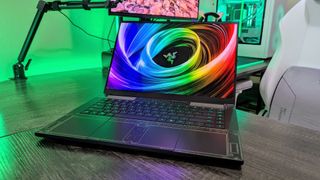
The Razer Blade has never been known for providing great value, and the Blade 16 does nothing to alter that reputation.
This flagship gaming laptop still rests at the pinnacle of luxury, so you'll have to pay a lot just to get through the door — and give up an arm or leg for every upgrade you stack on top.
The Razer Blade 16 (2025) starts from $2,999.99 at Razer, or $2,999.99 at Amazon, and that's equipped with an AMD Ryzen AI 9 365, NVIDIA GeForce RTX 5070 Ti, 32GB of RAM, and 1TB of SSD storage.
There are a handful of optional upgrades for the CPU, GPU, memory, and storage, with the fully maxed out Razer Blade 16 (2025) racking up a cost of $4,899.99 at Razer, or $4,899.99 at Amazon, which nets you a Ryzen AI 9 HX 370, RTX 5090, 64GB of RAM, and 4TB of SSD storage.
My Razer Blade 16 (2025) review sample is configured with the Ryzen AI 9 HX 370, RTX 5090, 32GB of RAM, and 2TB of SSD storage which would cost you $4,499.99 at Razer.
Spec | Razer Blade 16 (2025) |
|---|---|
Display | 16-inch OLED, 16:10 aspect ratio, QHD+ (2,560 x 1,600) resolution, 240Hz refresh rate, 0.2ms response time, 400nits max brightness, NVIDIA G-SYNC support, NVIDIA Advanced Optimus support, VESA DisplayHDR True Black 500 support, VESA ClearMR 10,000 support, 100% DCI-P3 Color Gamut & Calman Verified, non-touch |
CPU | Up to AMD Ryzen AI 9 HX 370 (Zen5 architecture, 12 cores, 24 threads, up to 5.1GHz) |
GPU | Up to NVIDIA GeForce RTX 5090 (Blackwell architecture, 24GB GDDR7 VRAM, up to 160W) |
NPU | AMD XDNA 2 (Up to 50 TOPS) |
Memory | Up to 64GB LPDDR5X @ 8,000MHz (Soldered) |
Storage | Up to 4TB M.2 2280 NVMe PCIe Gen 4x4 SSD (Expandable up to 8TB, 2 single-sided slots) |
Ports | 2x USB Type-C 4.0 (40GBps, 100W Power Delivery 3.0, DisplayPort 1.4), 3x USB Type-A 3.2 Gen 2 (10GBps), HDMI 2.1, SD Card Slot (UHS-II), 3.5mm audio jack, Kensington Nano Security Slot |
Connectivity | Wi-Fi 7 (802.11a/b/g/n/ac/ax/be 2x2), Bluetooth 5.4 |
Battery | 90Whr, 280W proprietary DC charger |
Audio & video | FHD (1080p) webcam w/ IR sensor for Windows Hello, dual-array microphones, six-speaker system (Smart Amp, THX Spatial Audio) |
Dimensions | 355 x 250.5 x ~14.9-17.4mm (13.98 x 9.86 x ~0.59-0.69in) |
Weight | 2.14kg (4.71lbs) |
Warranty | 1-year limited warranty (2-year limited battery warranty), RazerCare support |
It can't really be claimed that the Razer Blade 16 is a good deal, but the quality of hardware does reflect the price tag attached to it. Those who prioritize raw performance above all else, though, can get much more in far less expensive hardware (albeit hardware that will be thicker, heavier, and less premium).
If you'd like to purchase the optional extended and upgraded 3-year warranty (known as RazerCare), that will run you between $370 and $500 depending on if you want day-one accidental damage coverage.
In the box, you'll find the Razer Blade 16 (2025) and Razer's proprietary 280W DC charger.
Razer Blade 16 (2025) — Ryzen AI 9 365 | RTX 5080 | 64GB RAM | 2TB SSD
Buy now: $3,799.99 at Razer
Those buying the Razer Blade 16 likely aren't as concerned with the cost, but you're not likely to notice a major difference in performance between this 10-core CPU/RTX 5080-equipped configuration and the highest-end 12-core CPU/RTX 5090 Blade 16.
👉See at: Razer.com or Amazon.com
👀Configure your own: From $2,999.99 at Razer or Amazon
Razer Blade 16 review: Design and build quality

Razer Blade gaming laptops have been known for their anodized, matte black, CNC-milled unibody aluminum chassis for years, but the iconic design has grown stale over the past few generations thanks to iterative tweaks.
With the brand-new Razer Blade 16 (2025), the company finally went back to the drawing board, massively streamlining the design while retaining the iconic aesthetics.
I was immediately impressed by the redesign when I first went hands-on, and I haven't stopped being impressed since. Incontestable refinement, rather than gaudiness, helps this laptop stand out.
What exactly has changed, though? There are plenty of more subtle improvements, but Razer mostly trimmed the excess fat to craft the sleekest, thinnest Razer Blade laptop ever.
To be precise, the new Blade 16 is 14.9-17.4mm thin, approximately 21-32% thinner than last year. It also weighs 4.71lbs, a weight reduction of around 13%.
Razer softened the edges to make the Blade 16 more comfortable, too, and the redesigned thermal shelf provides the illusion of being even slimmer while also enabling excellent performance within the tighter confines.


Razer didn't drop a single port when making the transition, either. You still get a total of five USB ports, an HDMI 2.1 port, and a full-sized SD card slot, perfectly divided on each side.
Sure, you no longer get true Thunderbolt 4 thanks to the move to AMD instead of Intel, but the new USB4 ports are compatible with the vast majority of Thunderbolt accessories, and still support 100W Power Delivery and DisplayPort 1.4 output.
This is a fantastic redesign, once again establishing the Blade 16 as the ultimate luxury gaming laptop, and it's great that Razer didn't cut out ports or added touches like the LED Razer logo to achieve it.
There is still one major area for improvement, though, and that's the display. Despite Razer's obvious commitment to industry-leading hardware design, the Blade 16's screen is still glossy plastic, surrounded by raised plastic bezels. Most other premium, design-focused laptops use seamless, laminated glass for their screens, so I'd like to see Razer make the jump, too.
Razer Blade 16 review: Display quality
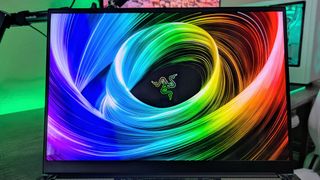
As I just mentioned, the display is the one area where Razer didn't alter much of anything. It's the same glossy, plastic, non-touch 16-inch display with the taller 16:10 aspect ratio, with the same impressive OLED panel behind it.
You're looking at a QHD+ resolution paired with a 240Hz refresh rate and a 0.2ms response time, a great set of specs that looks perfectly sharp at this screen size — and the Razer Blade 16 actually has the power to make use of that speed, too.
Being an OLED panel, the Blade 16 offers a dynamic visual experience, making full use of the vibrant colors and inky blacks to make all your video games and movies look their absolute best.
Performance is excellent, too, with no hint of ghosting, stuttering, or latency. Once you play games on a display of this caliber, it's nearly impossible to be satisfied with anything less.

Setting | Brightness | Black | Contrast | White point |
|---|---|---|---|---|
0% | 4.6 | 0 | Infinite | 6,500 (0.313, 0.331) |
25% | 36.5 | 0 | Infinite | 6,400 (0.314, 0.331) |
50% | 104.8 | 0 | Infinite | 6,400 (0.314, 0.332) |
75% | 224.9 | 0 | Infinite | 6,500 (0.313, 0.332) |
100% | 406.5 | 0 | Infinite | 6,500 (0.312, 0.331) |
The Razer Blade 16 may be a gaming laptop at its core, but Razer also aims it at creators and hardcore professionals who may need a color accurate display they can trust.
Fortunately, Razer delivers here with Calman Verified factory calibration for 100% of the DCI-P3 color gamut, as well as a variety of professional-tailored color profiles and even the option to build your own custom preset.
This laptop's display doesn't exceed expectations when it comes to brightness, but it crosses the 400nits threshold that I consider to be the minimum for an OLED-equipped laptop, and it gets dim enough for use in the darkest of environments.
White balance is remarkably consistent and even across brightness levels, too, making the Blade 16 a potentially invaluable tool for on-the-go creative work. A matte or at least properly anti-reflective glass screen would be great to see in the next Blade 16 laptop, but this is a fantastic display regardless.
It does use Pulse-Width Modulation (PWM) for dimming, though, which means the display flickers at a high rate to simulate lower brightness levels. The Razer Blade 16's OLED display does seem to flicker at higher rates than average, at least, so only those who are particularly sensitive should be affected.
Razer Blade 16 review: Performance and thermals
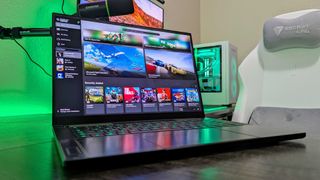
The Razer Blade 16 didn't just receive a redesign for 2025, it also switched from Intel to AMD Ryzen AI processors, a first for Razer and a major shift in general.
While AMD Ryzen AI is less powerful in some metrics than the previous Intel 14th Gen CPUs, it's more efficient and enables enhanced AI features and Copilot+ PC status thanks to its powerful integrated Neural Processing Unit (NPU).
The Blade 16 also marks the arrival of the long-awaited NVIDIA GeForce RTX 50-series of mobile GPUs, which promise improved performance, greater efficiency, and — of course — superior AI capabilities with features like DLSS 4.
That makes this Razer's first true AI PC, but how does it perform? In general, it feels excellent, as you'd expect with such powerful hardware under the hood.
I will say that AMD Ryzen AI isn't quite as snappy with waking from sleep as Intel or Qualcomm systems, but the Blade 16 feels just as smooth and responsive as the best Windows laptops.
Looking at the numbers tells a slightly more complicated story, though.






If you only looked at the numbers above, you may be confused. How is the new Razer Blade 16 supposed to be an upgrade when it's so clearly slower than last year's model?
While true in some ways, that fails to tell the whole story. The NVIDIA GeForce RTX 5090 isn't a substantial upgrade over its predecessor in raw performance, but is more efficient and more capable with AI features.
The AMD Ryzen AI chipsets are slower on paper than the Intel processors Razer used previously, but are significantly more efficient and run considerably cooler, on top of also enabling new AI features. Intel simply doesn't offer an equivalent right now.
No, the Razer Blade 16 (2025) isn't notably more performant than its predecessor, but that wasn't Razer's goal. The new Blade 16 is drastically slimmer, yet runs cooler and achieves the same (sometimes better) performance.
I ran this laptop through 3DMark's Time Spy benchmark 25 consecutive times, and the new Blade 16 achieved a 98.1% frame rate stability. When it comes to sustained performance, the new Blade 16 comfortably outpaces last year's version.
The fans are still loud but hum at a comfortably low frequency, and the Blade 16 never grew too warm to comfortably touch. It's a genuine improvement over last year, despite the size reduction.

Sustained performance matters, and the Razer Blade 16 (2025) also handles modern PC games incredibly well, even without relying on the RTX 50-series' new DLSS features.
- Forza Horizon 5 — 144 FPS (Extreme preset, 1600p resolution, 240Hz refresh rate, v-sync enabled, NVIDIA DLSS Super Resolution/Frame Generation/Reflex Low Latency disabled) | 211 FPS (Max settings, NVIDIA DLSS Super Resolution set to “Auto,” NVIDIA DLSS Frame Generation/Reflex Low Latency enabled)
- Gears 5 — 127 FPS (Ultra preset, 1600p resolution, uncapped framerate, v-sync enabled)
- Call of Duty: Black Ops 6 — 87 FPS (Extreme preset, 1600p resolution, 240Hz refresh rate, v-sync enabled, NVIDIA DLSS Super Resolution/Frame Generation disabled) | 96 FPS (NVIDIA DLSS Super Resolution set to “Quality”)
- Cyberpunk 2077 — 69 FPS (Ray Tracing: Ultra preset, 1600p resolution, 240Hz refresh rate, v-sync enabled, NVIDIA DLSS Super Resolution set to “Auto,” NVIDIA DLSS Frame Generation/Ray Reconstruction disabled, NVIDIA DLSS Reflex Low Latency enabled) | 51 FPS (Ray Tracing: Overdrive preset, NVIDIA DLSS Frame Generation/Ray Reconstruction enabled)
In Forza Horizon 5, the 2025 Blade 16 performed 11% better without using DLSS Super Resolution like the 2024 model. In Gears 5, I saw a 14% framerate improvement with identical settings. Cyberpunk 2077 is the only game that performed worse on the new laptop (4% worse, to be exact), and the slower AMD Ryzen AI chipset is likely to blame there.
I'm not convinced NVIDIA's DLSS 4 features are enough to justify a new generation of GPUs, but the Razer Blade 16 doesn't need them to perform well. Of course, it'll never be quite as powerful as other gaming laptops willing to pack on the grams and millimeters in exchange for better cooling.
Razer Blade 16 review: Software and AI experience

The Razer Blade 16 (2025) runs a clean build of Windows 11, with only minor additions from Razer.
By minor, I mean you'll find AMD and NVIDIA's software, Razer Synapse 4, and the dedicated Razer Chroma application. Razer doesn't even preinstall its own Cortex launcher and optimizer, which surprised me.
This laptop feels pretty stable and NVIDIA is regularly releasing new drivers for the RTX 50-series, but I did experience some small bugs. The laptop refused to remember my preference for the function row lock, for example.
I love seeing a distinct lack of bloatware, but the Razer Blade 16 is also devoid of any meaningful effort to take advantage of its "AI PC" status. Copilot+ PCs still add little of real value — and indeed many of the meager features are only just now reaching Intel and AMD systems.
Razer's AI investments are in their early days, too, and either way aren't reliant on the Blade 16's AI-centric hardware. You don't even get a proximity sensor for Human Presence Detection (HPD) features; the new Blade 16 is an AI PC in name only out of the box.
Still, you can easily find plenty of third-party apps and features that can take advantage of that AMD Ryzen AI NPU, and the Blade 16 will in theory become more intelligent over time as Razer, Microsoft, and everyone else develops their AI ecosystems.
Razer Blade 16 review: Battery experience

I had high hopes that the Razer Blade 16's transition to more efficient AMD Ryzen AI and RTX 50-series components would also lead to greater endurance from its massive 90Whr battery, but that's sadly not the case.
The Razer Blade 16 (2025) drained 24% of its battery in both of Procyon's one-hour battery tests, which loops a generic Microsoft Office workload or an HD video at 200nits display brightness and 50% volume.
Running a Windows Battery Report actually returned worse endurance versus last year's model, not even breaking the 4-hour mark. You can disable the NVIDIA GPU and other features to squeeze respectable life out of this laptop, but on default settings it simply doesn't last.
The bigger issue, though, is how much performance you lose when off the charger. In my testing, the Blade 16 lost 51% and 32% of its single and multicore performance, and 44% of its GPU performance, and that was on the highest possible performance profile.
That's a massive downgrade in performance, and it doesn't even translate to better battery life. Most egregious is the loss of single-core performance, which is actually noticeable in general computing.
Razer Blade 16 review: Keyboard and touchpad
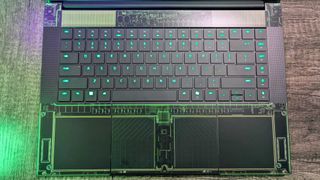
One of my most prominent complaints about the previous Razer Blade laptops was the shallow, lackluster keyboard that I wouldn't accept on any laptop, let alone a device built for gaming.
With the Blade 16 redesign, Razer heard our prayers and baked in an all-new keyboard, too. New, more durable switches with 50% more travel and an improved layout (including additional macro keys that you can customize) makes this the best keyboard on a Blade laptop, period.
HP and Lenovo still have Razer beat with some of their laptop keyboards, but the Blade 16 can finally play with the big dogs thanks to deeper, more tactile key actions. It's everything I want from a great keyboard.
Razer also takes full advantage of its best-in-class per-key RGB lighting (seriously, no one comes close here) with some awesome quality-of-life features. Hold down the "Fn" key, and all the shortcuts usable with it will be highlighted.
Now, dual-function keys also feature dual LEDs, meaning holding down the "Shift" key will switch the backlighting to the secondary symbols or functions. It's subtle enough that it could only be done in a super high-end laptop, but I like it.
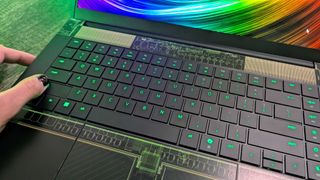
The gargantuan, glass Microsoft Precision touchpad makes a return, too, but Razer slightly shrunk it down after complaints that it was too easily touched when typing. It's a solid touchpad, but palm rejection is still not its strong suit, so accidental inputs haven't disappeared.
Large touchpads also make the inconsistent click action of the buttons more noticeable. That, combined with gamers' tendency to disable the touchpad when gaming, makes me wish that this was a large haptic touchpad.
Haptic touchpads provide an even "clicking" action across the entire surface, and when disabled simply become an unmoving glass sheet. Considering the Blade 16 is already ludicrously expensive, I don't think it's unreasonable to want all the premium features, haptic touchpads included.
Razer Blade 16 review: Other hardware
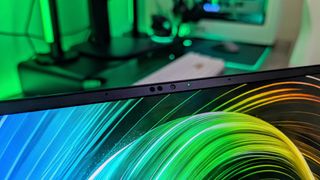
Many gaming laptops tend to slack on the finer details to focus on performance above all else, but the Blade 16 can't afford to do this — because the people who can afford the Blade 16 won't compromise.
As such, you get an FHD front-facing webcam that's not complete garbage, even if it doesn't exceed expectations. That camera is flanked by dual-array microphones and an IR sensor to enable Windows Hello facial recognition; the former are solid, and the latter is decently quick and reliable.
As I already mentioned, though, you won't find a proximity sensor here for HPD, nor will you find an ambient light sensor for automatic brightness or color temperature adjustment. There's also no privacy shutter, either physical or electronic. At least you get a Microsoft Pluton chip for enhanced security.

4For wireless connectivity, the Razer Blade 16 is on the cutting edge with Wi-Fi 7 and Bluetooth 5.4, and I had zero issues here.
I already mentioned the additional macro keys aligned on one side of the keyboard, with each possessing a standard function and a secondary function you can customize to your heart's content.
Finally, Razer actually added two more speakers to the Blade 16, for a total of six. These speakers support THX Spatial Audio and actually sound pretty great. They're not my absolute favorite I've heard, but they get loud and sound clear and defined at all volume levels, with more low end than your average laptop.
Razer Blade 16 review: Also consider
ASUS ROG Zephyrus G16 (2024) — Ryzen AI 9 HX 370 | RTX 4070 | 32GB RAM | 2TB SSD
Buy now: $2,299.99 at Best Buy
ASUS has gotten closest to usurping the Razer Blade 16 with the newly redesigned ROG Zephyrus G16, which is gorgeous, sleek, and powerful. It also costs hundreds less than Razer's offering, comes in Intel and AMD flavors, and is being updated with RTX 50-series GPUs. This is one of our favorite 16-inch gaming laptops.
👉See at: BestBuy.com
👀Also consider: ASUS ROG Zephyrus G16 (2024) w/ Core Ultra 9 | RTX 4080 | 32GB RAM | 2TB SSD for $2,274.99 at Best Buy
Lenovo Legion Pro 7i (Gen 9) — Core i9-14900HX | RTX 4080 | 32GB RAM | 2TB SSD
Buy now: $3,269.99 at Lenovo
The Legion Pro 7i is one of the most balanced and powerful high-end gaming laptops you can buy, and it will absolutely outperform the Razer Blade 16 while costing less. It's a fantastic laptop, but it's definitely not as luxurious, and the newest generation with RTX 50-series inside doesn't quite change that.
Windows Central review ⭐⭐⭐⭐½
👉See at: Lenovo.com
⏭️Next gen: Lenovo Legion Pro 7i (Gen 10) w/ Core Ultra 9 275HX | RTX 5080 | 32GB RAM | 2TB SSD from $3,439.99 at Lenovo
Razer Blade 16 review: Score card
Attribute | Rating & notes |
|---|---|
Value | ⭐⭐⭐ — The Razer Blade has never really been a great value, but you're paying more for a premium design that you simply won't find anywhere else. |
Design | ⭐⭐⭐⭐½ — The new Blade 16 redesign makes a huge difference, making the luxury gaming laptop thinner, lighter, and more comfortable to use. |
Display | ⭐⭐⭐⭐½ — This is the same display as last year, but it's still a fantastic screen for gaming, creation, and content consumption. |
Performance | ⭐⭐⭐⭐½ — The new Blade 16 doesn't outperform its predecessor, but it can keep up and even surpass it in the long run with superior thermal management. |
Software | ⭐⭐⭐⭐ — Razer's software doesn't really take advantage of the Blade 16's new "AI PC" capabilities, but this is a clean version of Windows with the features you need. |
Battery | ⭐⭐⭐ — New, more efficient hardware somehow doesn't translate to better battery life, with the Blade 16 also heavily throttling itself when disconnected from the charger. |
Keyboard | ⭐⭐⭐⭐½ — A new, deeper, and more feature-packed keyboard massively improves the overall Blade 16 experience, and the glass touchpad is still large and precise. |
Other hardware | ⭐⭐⭐⭐½ — Cutting edge connectivity, biometric authentication, and an excellent six-speaker sound system make up for the average webcam and lack of some ultra-premium features. |
Overall | ⭐⭐⭐⭐ — The new Razer Blade 16 finally puts the luxury brand back on the map with a beautiful redesign, reliable performance, and a keyboard you'll actually want to use. It's still ridiculously expensive, though. |
Razer Blade 16 review: My final thoughts
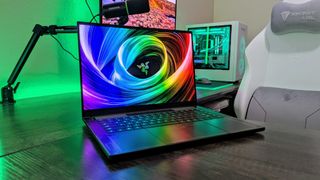
✅You should buy this if ...
- You want a gaming laptop that balances portability and performance.
- You don't mind paying a lot extra for an ultra-premium experience.
- You want a powerful laptop that also boasts a dedicated NPU for AI.
❌You should not buy this if ...
- You need the absolute best performance you can get for your money.
- You need a laptop that's performant on the charger and long-lasting off.
Razer genuinely improved the Blade 16 by leaps and bounds in a single generation. Of course, there are still changes I'd love to see in future iterations, like a glass display, haptic touchpad, and more of the features we've seen in premium Ultrabooks.
Those aside, though, the new Blade 16 is thinner and lighter than ever, but runs cooler and matches or exceeds the performance of its chunkier predecessor. This laptop finally feels like its hardware matches the exorbitant price tag again.
That said, you really need to want that "luxury design" to justify paying so much, especially if you're just looking for a ridiculously powerful gaming laptop that will rarely be too far from an outlet.
I also wish that battery life when off the charger was better, especially considering just how much performance you lose the moment you become unplugged. There are compromises to be made here, but I do have to admit the Razer Blade 16 (2025) is a beautiful and capable laptop that's much easier to recommend than last year's model.
Sold on this premium laptop and have the funds to acquire it? You can purchase the Razer Blade 16 (2025) from $2,999.99 at Razer right now.

There's still room for Razer to improve in future generations, but it's undeniable just how far the Blade 16 has come in a single year. This 16-inch, flagship gaming laptop is significantly better than what came before, even if it doesn't really perform better or last longer. If you're willing to pay the price, you'll be getting a pretty great laptop.

Zachary Boddy (They / Them) is a Staff Writer for Windows Central, primarily focused on covering the latest news in tech and gaming, the best Xbox and PC games, and the most interesting Windows and Xbox hardware. They have been gaming and writing for most of their life starting with the original Xbox, and started out as a freelancer for Windows Central and its sister sites in 2019. Now a full-fledged Staff Writer, Zachary has expanded from only writing about all things Minecraft to covering practically everything on which Windows Central is an expert, especially when it comes to Microsoft. You can find Zachary on Twitter @BoddyZachary.
You must confirm your public display name before commenting
Please logout and then login again, you will then be prompted to enter your display name.



